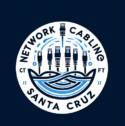What Are the Two Cabling Standards? A Simple Guide to TIA/EIA-568A and TIA/EIA-568B
If you’ve ever installed network cables or looked inside a wall jack, you may have noticed that the wires are color-coded in a specific pattern. These patterns aren’t random — they follow official cabling standards that make sure your network runs smoothly and devices communicate correctly.
In this guide, we’ll explain what the two cabling standards are, how they differ, and which one is right for your setup. Our team of structured cabling professionals in Santa Cruz ensures every installation follows the right cabling standards for efficiency and compliance.
What Are the Two Cabling Standards?
The two main wiring standards for Ethernet cables are:
- TIA/EIA-568A
- TIA/EIA-568B
Both are defined by the Telecommunications Industry Association (TIA) and the Electronic Industries Alliance (EIA). These standards ensure consistent, reliable connections for structured cabling systems, allowing different manufacturers and installers to work together using the same wiring methods.
Simply put — these standards define how the eight color-coded wires inside an Ethernet cable are arranged in the connectors (RJ45).
TIA/EIA-568A Standard
The 568A standard was the original wiring configuration approved in 1995. It was designed to support older telephone systems and is still used in government and residential installations.
Color sequence for 568A (from pin 1 to 8):
- White/Green
- Green
- White/Orange
- Blue
- White/Blue
- Orange
- White/Brown
- Brown
Key traits:
- Commonly used in residential and federal projects
- Backward compatible with older phone wiring systems
- Offers the same electrical performance as 568B
TIA/EIA-568B Standard
The 568B standard became more popular over time, especially in commercial and business installations. It’s now the most widely used standard for CAT5e, CAT6, and CAT6a cabling.
Color sequence for 568B (from pin 1 to 8):
- White/Orange
- Orange
- White/Green
- Blue
- White/Blue
- Green
- White/Brown
- Brown
Key traits:
- Commonly used in business and commercial environments
- Easier migration from older AT&T cabling systems
- Same speed and performance as 568A
The Main Difference Between 568A and 568B
The only real difference between the two standards is how the green and orange wire pairs are arranged. Functionally, both perform the same, but choosing one and staying consistent across all connections is crucial.
If you mix them up (for example, using 568A on one end and 568B on the other), you create a crossover cable — which is used for directly connecting two devices without a switch or router.
Which Cabling Standard Should You Use?
Both wiring standards work well, but here’s a quick guide to choosing the right one:
- For commercial and business networks: Use TIA/EIA-568B (the most common choice for CAT6 installations).
- For residential or government projects: Use TIA/EIA-568A, especially if following federal standards or existing wiring.
- For consistency: Always use the same standard on both ends of your cable for a straight-through connection.
The key is consistency — choose one and apply it across your entire network. These standards are part of a larger setup that includes several elements — explore the six main components of structured cabling to see how everything connects.
Why Following Cabling Standards Matters
Following wiring standards isn’t just about neatness — it’s about ensuring:
- Reliable signal transmission
- Reduced interference and crosstalk
- Easier troubleshooting and repairs
- Compatibility with future upgrades
- Compliance with building codes and industry best practices
When structured cabling follows the proper standard, you can connect devices confidently knowing your network will perform as expected.
Professional Installation Makes a Difference
Even though cabling standards may seem simple, proper installation takes skill and precision. Certified low-voltage or network cabling installers understand how to:
- Terminate and test cables correctly
- Maintain the correct bend radius and cable length
- Prevent data loss from interference
- Follow California or local building codes
Hiring a professional ensures your cabling system performs at its peak — and remains reliable for years to come.
Final Thoughts
So, what are the two cabling standards?
They’re TIA/EIA-568A and TIA/EIA-568B, and both provide the foundation for reliable Ethernet and structured cabling systems around the world. Understanding these standards is essential before you install a network, ensuring all connections meet professional guidelines.
While either can be used, 568B is generally the go-to for modern commercial installations. The most important rule? Pick one and stay consistent — that’s the secret to a strong, stable network.
